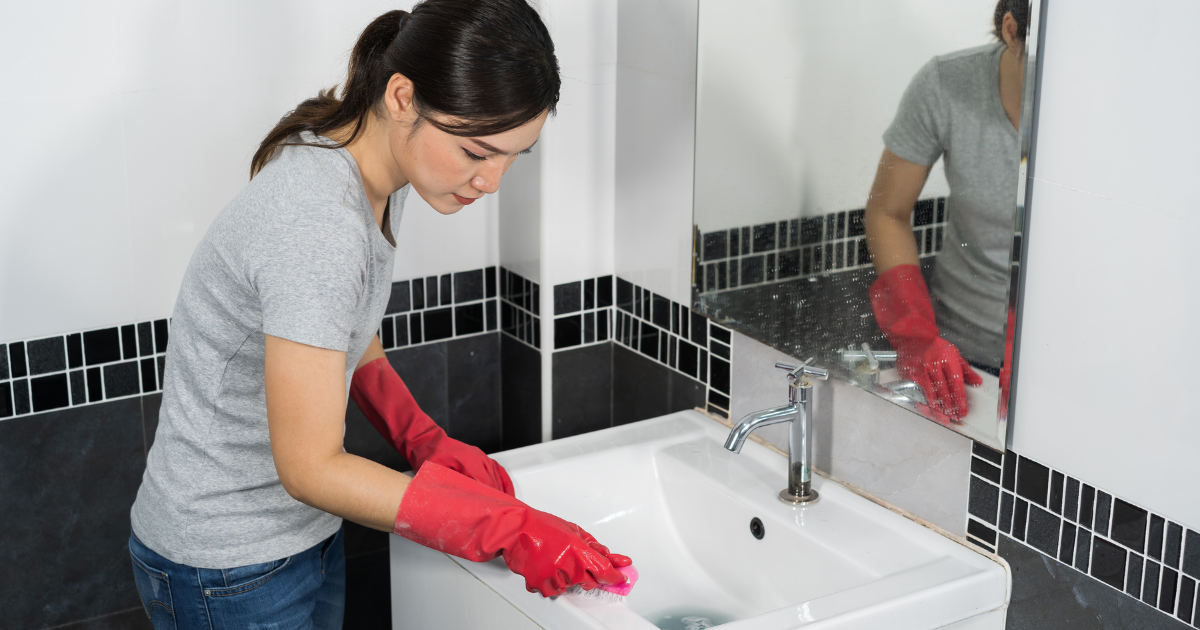How to Clean a Bathroom Sink Drain that Smells

In this D.I.Y. I will show you how to clean a bathroom sink drain that smells. Does your bathroom sink drain smell a lot despite your best efforts of keeping it as clean as possible? Your toilets may be spick and span; your bathrooms may have beautiful plants and air fresheners, but your bathroom sink drain may still emanate a foul smell. Have you ever wondered why? If yes, you have come to the right place. Here, you will not only get to know some of the top reasons why your bathroom sink drains smell, but you will also learn some tips & tricks to get rid of these smells completely.
What are the common reasons for the foul smell from bathroom sink drains?
Whenever you notice a foul smell coming from your bathroom sink drains, please be informed that it could be due to one of the following reasons:
- Bacteria and biofilm buildup in the sink
- Issues with the sewer line in the drainage system
- Improper ventilation in the sewer line
- P-Trap going dry
- Sewer gas getting into the P-Trap
- Clogs in bathroom drains
Listed below are some of the common methods you can try at home to correct these issues, so that you can get rid of the foul smell from your bathroom sink drains forever.
Getting rid of bacteria-related odor
What do you need?
- Boiling water – 1 pan
- Baking soda – ½ cup
- Vinegar – 1 cup
- Enzymatic cleaner (optional)
Process
- A pot of boiling water helps to loosen the debris and bacteria accumulated in the bathroom sink drains. Pour a pot of boiling water directly into the drain.
- You can mix ½ cup of baking soda and 1 cup of vinegar to make a paste. Apply this over the drains and allow the mixture to remain there for about 30 to 60 minutes.
- Thanks to their chemical properties, both baking soda and vinegar help in getting rid of the bad odor from the drains.
- After 3o or 60 minutes, flush the drain using hot water.
- If you still notice a foul odor, you can pour a small quantity of enzymatic cleaner (use the ones with natural enzymes only) over the drain, and flush it with hot water to get rid of the bad odor completely.
Using only boiling water
- Boiling water – 1 pot
- Degreasing liquid dish soap – a small quantity
Process
- Mix about 2 tablespoons of degreasing liquid dish soap with boiling water.
- Pour half of this solution into the drain directly and wait for about 5 to 10 minutes for it to loosen the debris inside the drain.
- Pour the rest of the solution after 10 minutes and flush thoroughly to get rid of foul odors from the drain.
- This method will work for slight odors.
Using only vinegar
- Hot White Vinegar – 4 cups
Process
- Pour 4 cups of white vinegar into a pot and boil it. Switch off the stove when the vinegar starts to bowl.
- Pour two cups of the boiling vinegar down the drain and wait for at least 2 to 5 minutes. This will give time for the vinegar to act on the debris inside the drain and remove biofilm and bacterial buildup.
- Pour the remaining 2 cups of boiling vinegar down the drains. The loosened debris will be removed in this step, which leads to the elimination of bad odor as well.
- Flush the drain with cold water.
- This method works well to get rid of oil, grease, grime and biofilm buildup in the drain.
Getting rid of clogs–related odor
What do you need?
- Any clog-removing tool like a plunger, wire hanger, drain snake and the like
- Wrench
- Bucket
- Cleaning Brush
- Enzymatic Cleaner (optional)
Process
- Removing the clogs inside the drain can be done with any tool that you have. If you have a plunger, you can place it over the drain, and apply pressure with your hand to loosen the debris and unclog the drains.
- For tough debris, you can use clog-removing tools like tweezers, needle-nose pliers, draining snakes, straightened wire hangers and the like. Use these tools to scrape out the debris from the insides and walls of the drain.
- Use a plug wrench to remove the sink trap. Place a bucket underneath the sink to hold the water that may come out while removing the trap.
- With the help of an old toothbrush, get rid of the clogs in the trap by brushing it thoroughly.
- In case foul odors still persist, you can consider pouring a little quantity of natural enzymatic cleaner solution over the drain directly.
- Flush with cold water to bid goodbye to foul odor from sink drains.
Getting rid of smelly drains of a washing machine
What do you need?
- Warm water – 1 gallon
- White vinegar – 1 quart
- Cold Water- 1 gallon
Process
Checking for odor due to sewer gases
Process
- Always ensure that the water in the P-traps is full. When the P-traps dry out, sewer gases enter into this, causing a foul smell from your bathroom sink drains.
- Run water for about 10 minutes to increase the water level in the P-Trap.
- If this problem occurs in guest bathrooms (which are rarely used), you can add a few drops of mineral oil to the water in the trap. This will aid in slow evaporation, and reduces instances of the P-Trap becoming dry.
- Look for the vent pipes that are connected to the drain pipes in the P-Trap. If these vent pipes are not properly ventilated, it may lead to a foul odor from bathroom sink drains. You can get a professional to sort out the ventilation in these pipes, as this is a complex DIY project.
Additional tips and advice
- Never use bleach while getting rid of foul smells from bathroom sink drains. You should always try simple products like baking soda and vinegar. Usually, these do the trick. In rare instances, you can use a natural enzymatic cleaner or organic drain cleaner to get rid of the debris and bacteria accumulated inside.
- Always find out the reason for the foul smells before you set out to try DIY tricks to get rid of them. Using the wrong method will not only prolong the process, but will also compel you to deal with the foul smells for a longer period of time.
- Seek professional help if you have no clue about the plumbing or draining system in your home. This will save you time and money in the long run.
